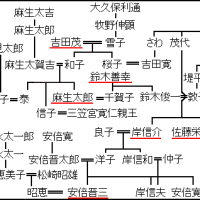It seems that something very sad has become a reality.
Genetically modified human twins have been born.
Their genes may cover the world from now on.
Gene recombination half, genetically modified quota.
And conflict between discriminator and human rights protection group. However, the genes of human beings may be mixed with recombined genes and form unnatural humanity in future generations.
I remember this kind of permission as passed by the British Parliament.
How should we consider the two lives that have been born?
It will not be like this movie.
Lucy TRAILER 1 (2014) - Luc Besson, Scarlett Johansson Movie HD
とても悲しいことが現実となってしまったようだ。
遺伝子組み換え人間の双子が生まれてしまった。
彼らの遺伝子がこれから世界を覆っていくかもしれない。
遺伝子組み換えのハーフ、遺伝子組み換えのクオータ。
そして差別者と人権保護団体との衝突。しかし人類の遺伝子が組み替えられた遺伝子と交じり合って、後世の不自然な人類を形成していくかもしれない。
こういう許可をイギリス議会でも可決しているように記憶している。
産まれてしまった二つの命をどう考えればいいのだろうか。
Monsanto/Bayer Moving to Genome Edit Fruits and More
Not surprising, Monsanto, today hidden behind the Bayer logo, as the world leader in patented GMO seeds and the probable carcinogenic Roundup herbicide with glyphosate, is attempting to quietly patent genetically modified or GMO varieties of fruits using controversial gene-editing. The “beauty” of this for Monsanto/Bayer is that in the USA, according to a recent ruling by the US Department of Agriculture, gene-edited agriculture needs no special independent testing. The developments are not good for human health or safety, nor will it do anything to give the world better nutrition.
The agrichemical and GMO giant Monsanto, which today tries to keep a lower profile inside the German agrichemical and GMO giant Bayer, is moving into the highly controversial domain of gene-editing of new crop varieties. In 2018 as the company was being deluged with lawsuits over its use of the probable carcinogen, Roundup, Monsanto invested $125 million in a gene-editing startup called Pairwise. The link is anything but casual.
Former Monsanto Vice President for Global Biotechnology, Tom Adams, has taken the post of CEO of Pairwise. In short, this is a Monsanto gene-editing project. In a press release, Pairwise says it is using the controversial CRISPR gene-editing technology to create genetically edited produce. Among their goals apparently is a super-sweet variety of strawberry or apples, just what our sugar-saturated population doesn’t need.
CRISPR gene-editing, a stealth attempt by the global agribusiness industry to promote artificial mutations of crops and, as the world was shocked recently to hear, even humans, as in China, is being advanced, much like GMO crops falsely were, as solution to world hunger. Pairwise founder, Keith Joung, told media that their CRISPR gene-edited fruits, “will speed innovation that is badly needed to feed a growing population amid challenging conditions created by a changing climate.” How sweeter genetically-edited strawberries will solve world hunger he leaves to the imagination. Pairwise also says that gene-edited fruits would somehow also cut down on food waste. One has to be also skeptical there as well, even if it makes nice promotion copy. In addition to super-sweet strawberries, Monsanto plans to use its work with Pairwise to develop new varieties of gene-edited corn, soybeans, wheat, cotton and canola crops. And because the USDA unfortunately has given the green light, the new genetically modified foods will undergo no independent testing for health and safety.
USDA’s Foolish Ruling
The US Department of Agriculture recently made a ruling that CRISPR and other new gene-editing of food products need no special regulatory oversight or independent testing. USDA Secretary Sonny Perdue announced in 2018 reaffirmation of an Obama-era ruling exempting gene-edited crops from special testing. In a press release, Purdue stated that the USDA won’t regulate plant breeders who use gene-editing techniques without introducing genes from another species, or “plants that could otherwise have been developed through traditional breeding techniques.” The statement added that, “USDA seeks to allow innovation when there is no risk present.” The problem is that there has been no exhaustive scientific testing by any us government agency or others to prove no risk in gene-edited plants.
Fortunately, in a ruling that takes the health and safety of the population more seriously, the European Court of Justice (ECJ) — the highest court in the European Union — ruled last year that gene-edited products should be treated like genetically modified organisms (GMOs), which are subject to substantial regulation in the EU.
That ruling has drawn howls of protest from the likes of Monsanto/Bayer but to date, it stands. This makes the USA the focus of agricultural gene-editing developments, likely bad news for the American population which is already–as a result of an executive policy ruling made by then-president G.H.W. Bush in 1992–consuming a diet heavily saturated with GMO soy, rice, corn, potatoes, sugar beets and other products, even GMO insulin for diabetes.
Risk-free?
The recent attention given to a Chinese biophysicist who went public with claims he had successfully gene-edited a human embryo to make the new-born twins “HIV-immune” has turned the world attention to the relatively unpublicized genetic manipulation technology known as gene-editing. That was bad news for companies like Monsanto/Bayer who had been hoping to advance their dreams of genetic manipulation under the rubric of “biotechnology,” to avoid the Frankenfoods label the world put on the earlier GMO technology.
Whether the current USDA Secretary Perdue simply relied on the earlier arguments of bureaucratic appointees of the previous pro-GMO Obama administration, clearly it warrants a serious re-examination.
The CRISPR-Cas9 technology which has transformed the gene-editing landscape is merely five or so years in existence. The risks have largely been left to individual scientists to reveal. In one such study, published in May, 2017 in Nature magazine, gene-editing researchers reported they were shocked to find an unexpectedly high number of secondary mutations in a mouse model of gene therapy. In other words, results were not predictable.
When Chinese biophysicist He Jiankui shocked the world in December, 2018 by announcing he had used CRISPR to alter a gene in human embryos in the womb of a woman, who gave birth to twin girls in November, the Chinese authorities tried to silence the affair by putting He under house arrest, some suggesting he may even have been sentenced to death. What biophysicist He did, obviously with little regard to the genetic consequences, was gene-editing of the so-called germ-line. Changing the genes in an embryo means changing genes in every cell. If the method succeeds, the baby will have alterations that will be inherited by all of the child’s progeny in incalculable ways. If the mouse studies are any indication, the unintended consequences could be horrendous, not just for the two unwitting Chinese newborn twins.
The implications of gene-editing using CRISPR and its modifications are so grave as to warrant the utmost caution before unleashing it on to the world market. Unfortunately, the opposite seems to be the case. Gene-editing kits can be bought by anyone online without proof of scientific qualifications, and for little money. Calls for a moratorium on gene-editing until the technology has been proven or disproven go unheeded. President Obama’s Director of Intelligence, James Clapper, even had genome-editing on the list of “weapons of mass destruction and proliferation.” The Pentagon DARPA is reportedly doing research on weaponizing certain varieties of mosquitoes. Anything is possible.
It is long overdue to invoke the prudent “precautionary principle” by imposing a global moratorium on gene-editing pending far more controlled independent research before we perhaps one day learn that gene-edited strawberries, ever so sweet, can destroy life inadvertently or by design.
F. William Engdahl is strategic risk consultant and lecturer, he holds a degree in politics from Princeton University and is a best-selling author on oil and geopolitics, exclusively for the online magazine “New Eastern Outlook.”
https://journal-neo.org/2019/01/18/monsanto-bayer-moving-to-genome-edit-fruits-and-more/
果物やそれ以外でも「ゲノム編集」を進めようとしているモンサント/バイエル
F. William Engdahl
2019年1月18日
New Eastern Outlook
現在、特許取得済みのGMO種子と、発がん性の可能性があるグリホサートを含むラウンドアップ除草剤で、世界をリードしている、バイエルのロゴの後ろに隠れたモンサントが、論争の的であるゲノム編集を使った、遺伝子操作されたGMO変種の果物について、特許を密かに取ろうと試みているのは驚くべきではない。モンサント/バイエルにとって、この「素晴らしい点」は、アメリカ農務省による最近の決定によれば、ゲノム編集された作物には、特別な独立したテストは不要なのだ。この開発はヒトの健康や安全に良くはなく、同様に、世界にとってより良い栄養を与えることにもなるまい。
現在、ドイツの農薬・GMO大手のバイエル内部で、目立たないようにしている巨大企業モンサントは、新しい作物品種のゲノム編集という、大いに論争の的になっている分野に入り込みつつある。2018年、同社に、発がん性物質の可能性があるラウンドアップ使用に対する訴訟が殺到していた頃、モンサントはペアワイズと呼ばれるゲノム編集の新興企業に1億2500万ドル投資した。両者の関係は、思いつきとはほど遠いものがある。
グローバル・バイオ工学部門の前モンサント副社長トム・アダムスが、ペアワイズCEOの地位についた。要するに、これはモンサントのゲノム編集プロジェクトなのだ。報道発表で、ペアワイズは、物議の的になっているゲノム編集された作物を作るCRISPRゲノム編集技術を使っていると述べている。どうや、彼らの目標の中には、既に砂糖で飽和しているアメリカ国民には不要な超甘い種類のイチゴやリンゴがあるようだ。
世界が最近聞いてショックを受けたように、中国のように、人にすら行う、グローバルな農業関連産業産業による密かな企みである、農作物の人工的突然変異を促進するCRISPRゲノム編集は、GMO農作物と同様、世界の飢えに対する解決策と偽って、推進されている。ペアワイズ創設者キース・ジョンは、マスコミに、CRISPRゲノム編集された果実は「ひどく変化する気候によってもたらされる困難な状態の中で増大する人々を食べさせるのに必要な革新を速める」と述べた。より甘くゲノム編集されたイチゴが、彼が想像に任せている世界の空腹感をいったいどう解決するのだろう。ペアワイズは、ゲノム編集された成果は、同様に、何らかの方法で食べ残しを減らすと言う。たとえそれが宣伝用コピーとして素晴らしいとしても、人は懐疑的になるべきだ。超甘いイチゴのほかに、モンサントはその仕事をペアワイズと共に、ゲノム編集したトウモロコシ、大豆、小麦、綿やキャノーラ作物の新種開発に使う計画だ。アメリカ農務省が不幸にも承認してしまったので、新しい遺伝子組み替え食品は、健康と安全のための独立したテストは受けないだろう。
アメリカ農務省の愚かな決定
アメリカ農務省は最近CRISPRや食品の他の新しいゲノム編集には、特別な規制上の監督や、独立したテストは必要ではないという決定をした。2018年に、ソニー・パーデュー農務省長官は、ゲノム編集された農作物を、特別なテストから免除するという、オバマ時代の裁定の再確認を発表した。パーデュー長官は、報道発表で、別の種からの遺伝子を導入しないゲノム編集技術を使う植物育種家、あるいは「伝統的な繁殖テクニックによって開発できたはずの作物」を、アメリカ農務省は規制しないと述べた。声明は更に「危険が存在していない場合、アメリカ農務省は革新を許すようつとめる」と付け加えた。問題は、いかなる行政機関や、他の人々による、ゲノム編集された植物に危険がないことを証明する、徹底的な科学検査も存在しないことだ。
幸い、健康と住民の安全をより真剣に受けとめる欧州裁判所(ECJ)、欧州連合最高裁判所の裁定で、去年、EUでは、ゲノム編集された作物は、遺伝子組み替え生物(GMO)と同じに扱われ、かなりの規制が適用されるよう裁定された。
この裁定はモンサント/バイエルなどの大反対を招いたが、今も有効だ。1992年、当時のG.H.W.ブッシュ大統領による大統領命令の結果として、GMO大豆、米、トウモロコシ、ジャガイモ、サトウダイコンや他の作物に満ちた食事や、糖尿病のためのGMOインスリンさえ既に摂取しているアメリカ人にとって、悪いニュースとなる可能性が高い農業ゲノム編集開発の場としてのアメリカに焦点が当てられることになる。
安全か?
新生児の双子に「HIV免疫をもたせる」よう、人間の胎芽を成功裏にゲノム編集したという主張を公にした中国人生物物理学者に対する最近の注目は、世界の注意を遺伝子編集として知られている比較的公表されていない遺伝子操作技術に向けた。「バイオ工学」の名の下で、彼らの遺伝子操作の夢を推進して、遺伝子組み換え食品を避けることを望んでいたモンサント/バイエルが世界がより以前のGMO技術に置かれると判別するように、それは会社のために悪いニュースだった。
現在のパーデュー農務省長官が、オバマ政権被任命官僚によるGMO賛成の主張に依存しているか否かにかかわらず、重大な再考が必要なのは明らかだ。
遺伝子編集の状況を一変させたCRISPR- Cas9技術は、出現してわずか5年かそこらに過ぎない。危険の暴露は、もっぱら個々の科学者に依存している。2017年5月に、ネイチャー雑誌に発表された、ある研究では、遺伝子編集研究者が、遺伝子治療のネズミ・モデルで、 二次突然変異の思いがけなく高い値を発見して衝撃を受けたと報告した。言い換えれば、結果は予測可能ではなかったのだ。
2018年12月に中国人生物物理学者の賀建奎が、11月に双子の少女を出産した女性の子宮内で、胎児の遺伝子を変えるためにCRISPRを使っていたと発表し、世界に衝撃を与え、中国当局は、事件を鎮静させようと、彼を自宅軟禁し、一部の人々は彼が死刑判決をされたかもしれないとを示唆している。彼は、生物物理学者として、遺伝結果を、明らかにほとんど考慮せずに、いわゆる生殖細胞系の遺伝子を編集した。胎芽の遺伝子を変えることは、すべての細胞の遺伝子を変えることを意味している。もし、この方法が成功するなら、赤ん坊には、数え切れない数の子孫のすべてに継承されるだろう変化があるのだ。もしネズミの研究が何らかの参考になるとすれば、思いがけない結果は恐ろしいもので、意図しない2人の中国新生児の双子だけでは済まない。
CRISPRと、その変化を利用した遺伝子編集の重みは、世界市場に、それを解放する前に、最大の警告が正当化されるぐらいに重大だ。不幸なことに、その逆が事実であるように思われる。遺伝子編集キットが、オンラインで、科学的な資格を持っている証明なしで、誰でも、ごくわずかの費用で買うことができる。技術が証明されるか、反証が無視されないようになるまで、ゲノム編集の停止を要求する。オバマ大統領の国家情報長官ジェームズ・ クラッパーは「大量虐殺兵器と拡散」のリストに、ゲノム編集を載せさえしていた。国防総省DARPAは、伝えられるところによれば、特定の様々な蚊を武器化することについての研究をしている。何でも可能なのだ。
おそらく、いつの日か、遺伝子編集された非常に甘いイチゴが、うっかり、あるいは意図的に、命を破壊しかねないのだと知るようになる前に、遥かに管理された独自の研究ができるようになるまで、遺伝子編集に世界的な一時停止を課し、慎重な「予防原則」を発動させことは、長年の懸案だ。
*
F. William Engdahlは戦略危険コンサルタント、講師。彼はプリンストン大学の政治学位を所有している石油と地政学のベストセラー作家。オンライン誌「New Eastern Outlook」独占記事。
記事原文のurl:https://journal-neo.org/2019/01/18/monsanto-bayer-moving-to-genome-edit-fruits-and-more/
http://eigokiji.cocolog-nifty.com/blog/2019/01/post-e0a2.html

























